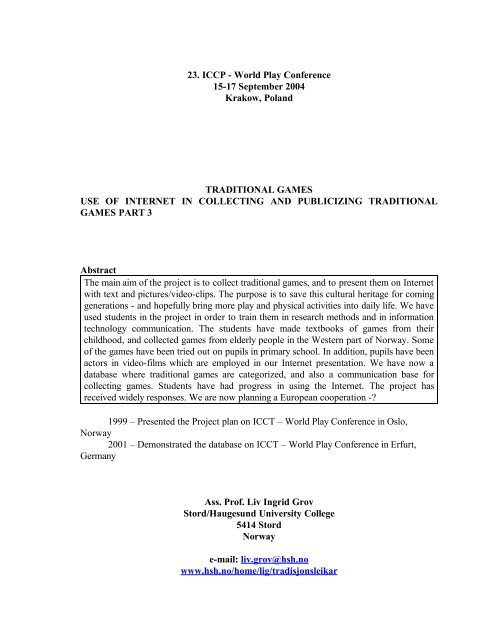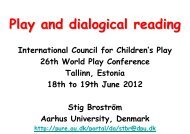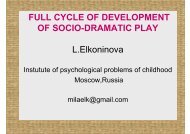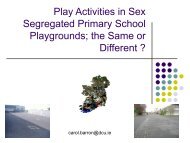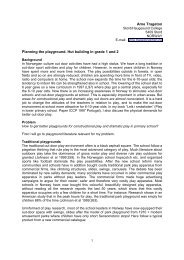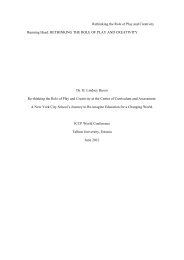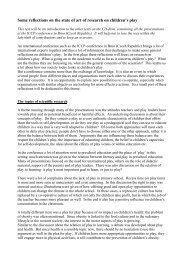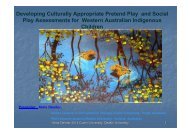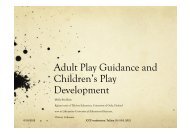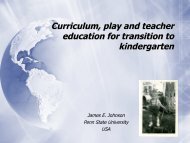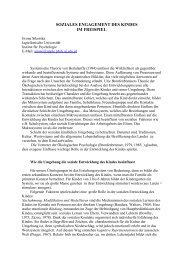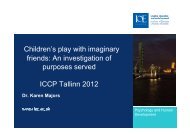23. ICCP - International Council for Children's Play
23. ICCP - International Council for Children's Play
23. ICCP - International Council for Children's Play
You also want an ePaper? Increase the reach of your titles
YUMPU automatically turns print PDFs into web optimized ePapers that Google loves.
<strong>23.</strong> <strong>ICCP</strong> - World <strong>Play</strong> Conference<br />
15-17 September 2004<br />
Krakow, Poland<br />
TRADITIONAL GAMES<br />
USE OF INTERNET IN COLLECTING AND PUBLICIZING TRADITIONAL<br />
GAMES PART 3<br />
Abstract<br />
The main aim of the project is to collect traditional games, and to present them on Internet<br />
with text and pictures/video-clips. The purpose is to save this cultural heritage <strong>for</strong> coming<br />
generations - and hopefully bring more play and physical activities into daily life. We have<br />
used students in the project in order to train them in research methods and in in<strong>for</strong>mation<br />
technology communication. The students have made textbooks of games from their<br />
childhood, and collected games from elderly people in the Western part of Norway. Some<br />
of the games have been tried out on pupils in primary school. In addition, pupils have been<br />
actors in video-films which are employed in our Internet presentation. We have now a<br />
database where traditional games are categorized, and also a communication base <strong>for</strong><br />
collecting games. Students have had progress in using the Internet. The project has<br />
received widely responses. We are now planning a European cooperation -?<br />
1999 – Presented the Project plan on ICCT – World <strong>Play</strong> Conference in Oslo,<br />
Norway<br />
2001 – Demonstrated the database on ICCT – World <strong>Play</strong> Conference in Erfurt,<br />
Germany<br />
Ass. Prof. Liv Ingrid Grov<br />
Stord/Haugesund University College<br />
5414 Stord<br />
Norway<br />
e-mail: liv.grov@hsh.no<br />
www.hsh.no/home/lig/tradisjonsleikar
2<br />
CONTENT<br />
1 BACKGROUND<br />
1.1 Initiative - Worries p. 3<br />
1.2 Links to curriculum plan (L97) p. 4<br />
1.3 Links to other projects p. 4<br />
2 PLAN S FOR THE PROJECT<br />
2.1 Aims <strong>for</strong> the project p. 5<br />
2.2 Presentation of the project p. 5<br />
2.3 Changes in the project p. 6<br />
2.4 Methods in data collection and involving p. 6<br />
3 ABOUT TRADITIONAL GAMES<br />
3.1 Traditional games – Role games p. 7<br />
3.2 Categorising p. 7<br />
4.0 STATUS: RESULT AND PRODUCTS 1.SEPT.2004<br />
4.1 Collecting games p. 10<br />
4.2 Trying out collected games p. 11<br />
4.3 Products published on Internet p. 11<br />
4.4 Products of textbooks and widow-film p. 11<br />
4.5 Other publishing p. 12<br />
5.0 SUMMERY AND FURTHER WORK<br />
5.1 Summery p. 13<br />
5.2 Further work p. 14<br />
6.0 REFERENCES p. 15<br />
Ass. Prof. Liv Ingrid Grov<br />
<strong>ICCP</strong>-World <strong>Play</strong> Conference<br />
Stord/Haugesund University College 15-17 September 2004<br />
5414 Stord Akademia Pedagogiczna<br />
Norway KPPiS, ul. Ingardena 4<br />
e-mail: liv.grov@hsh.no<br />
Dr.Krzysztof Kraszewski
3<br />
www.hsh.no/home/lig/tradisjonsleikar<br />
PL – 30 060 Krakow<br />
TRADITIONAL GAMES<br />
USE OF INTERNET IN COLLECTING AND PUBLICIZING<br />
TRADITIONAL GAMES PART 3<br />
1.0 BACKGROUND<br />
In the last century we have had big changes with new industries, changes in settlement and<br />
families - cars, TV, computers and so on. This has of course changed the children`s daily life<br />
- and specially their play and physical activities.<br />
1.1 Initiative - Worries<br />
The College was contacted by a film producer (<strong>for</strong>mer teacher), who was worried about<br />
children’s activities - children did not play all kinds of old games as be<strong>for</strong>e. He asked:<br />
“Where are children’s own games? Are we losing the old games, which have been played <strong>for</strong><br />
generations? Are we organising children too much? What can we do to secure that the<br />
traditional games will be saved and used by children? Can traditional games bring more<br />
physical activities into children’s daily life?” Questions like these has been asked word vide<br />
in the modern time.<br />
Bishop & Curtis (2001) says in their introduction of their book:<br />
In Britain the popular perceptions that `children don`t know how to play any more`<br />
and that `the traditional games are disappearing` seem never to have been so<br />
widespread as in the early twenty-first century.(…) Parallels to this views are found<br />
in other parts of the western word. (…) such views are also prevalent in North<br />
America and Australia (2001:1).<br />
1.2 Links to curriculum plan
4<br />
The new National Curriculum Plan (L97) in Norway focuses on aspect of culture, play and<br />
physical education. It says that physical activity is essential to the physical, mental and social<br />
development of children and young people. Because of changes in ways of life and leisure<br />
facilities, with fewer opportunities <strong>for</strong> all-round physical activity, more and more people are<br />
devoting less time to physical labour, play, sports and outdoor adventure activities. School<br />
environments must there<strong>for</strong>e invite and provide scope <strong>for</strong> physical activity. – We often sees<br />
that schoolyards are prepared <strong>for</strong> sports games as football, handball, basketball and have less<br />
room <strong>for</strong> the children`s own games – and traditional games.In elementary school the pupils<br />
have 1 or 2 lessons (periods) a week in physical education – but the curriculum plan says<br />
that:<br />
Children learn with all their senses and by actively using their bodies. They must<br />
there<strong>for</strong>e be given plenty of time <strong>for</strong> play and other physical activities throughout<br />
the school day and not just in the physical education periods and breaks between<br />
lessons. <strong>Play</strong> is a way of maintaining traditions, giving the pupil mastery of his or<br />
her own body, and developing creativity. <strong>Play</strong> is a natural starting point <strong>for</strong><br />
physical education and an important part of the entire curriculum (L97: 263).<br />
The traditional games are also relevant in new teaching methods such as theme based - and<br />
project work.<br />
1.3 Links to other projects<br />
The College had already other research projects, which were closely linked to «Traditional<br />
games»: * Legends in Sunnhordland (Nils Tore Økland/Bjørn Bjørlykke)<br />
* Folk music (Fred Ola Bjørnstad)<br />
* Folk dance (Liv Ingrid Grov)<br />
We created a project group together with Brynjar Stautland, the film producer.<br />
«Legends in Sunnhordland» is already presented on Internet, and we also want to use a<br />
similar presentation <strong>for</strong> traditional games.<br />
All these aeries are focused on in the new curriculum plan (L97).<br />
2.0 PLANS FOR THE PROJECT
5<br />
2.1 Aims <strong>for</strong> the project<br />
The main aim and purpose <strong>for</strong> the present project is:<br />
• To collect traditional games, especially of physical skills<br />
• Present them in various media as textbooks, video and on Internett<br />
• To enable coming generations to use traditional games easily<br />
• To train students in research methods<br />
• To train students in in<strong>for</strong>mation communication technology (ICT)<br />
2.2 Presentation of the project<br />
Sydvest – adv. agency<br />
* Idea - Concept<br />
* Organising<br />
* Make video-film<br />
* Editing<br />
HSH - College<br />
* Idea - Concept<br />
* Collect games (students)<br />
* Practising games<br />
* Internet - Database<br />
Training-schools<br />
* Trying out games<br />
* Use games in P.E.<br />
* Use games in theme-<br />
based/project work<br />
Product Sydvest – adv.agency<br />
* Video <strong>for</strong> use in school<br />
* Textbook<br />
* TV-programme<br />
Product HSH – College<br />
* Publishing on Internet<br />
* Produce wideo-snaps<br />
* Database <strong>for</strong> collcting and<br />
communicasjon<br />
This overview gives a concentrated presentation of the project and how the different<br />
tasks are distributed - and what sort of product we might develop.<br />
2.3 Changes in the project
6<br />
The project group functioned the first year when we planned the project - and tried to get<br />
money <strong>for</strong> film- and video production. We were not successful in business. The film<br />
producer became freelance - he started on other tasks – but is still interested in making a<br />
TV-program about traditional games. My college had plenty to do on other research work –<br />
so I continued on my own - with some recourse from the College until 2001.<br />
Since 2001 I have not had extra reassures to follow up the project. This year about<br />
30% of my job is available <strong>for</strong> the project!<br />
2.4 Methods in data collection and students involving<br />
To reach the aims, the students had to do field research of actions type (Mac Karnan 1998).<br />
Be<strong>for</strong>e this project started, students in physical education had collected games from their<br />
own childhood. Each student choose two different games – practised them on the student<br />
group – to be sure how to play. The students wrote down their games – and we made<br />
textbooks out of it. – Each student could now use the collection of games in their work.<br />
We wanted to continue this method in the project. The next task <strong>for</strong> the students was to<br />
interview their parents, grandparents or elderly people back home. For this work the<br />
students will use an interview-guide. We also want to use literary sources. - Once the<br />
database on Internet was operating the student registated the games in the database. The<br />
communication base will be open <strong>for</strong> anyone who wants to support us with traditional<br />
games. The first years we want to concentrate the research to the western part of Norway -<br />
where the majority of the student comes from (Hordaland/Rogaland). But we are also<br />
interested in games from other parts of Norway and from <strong>for</strong>eign countries. If it is possible<br />
we want to expend the project to national and European level -?
7<br />
3.0 ABOUT TRADITIONAL GAMES<br />
3.1 Traditional games – Rule games<br />
What are traditional games? The approach of traditional games is in this context the same as<br />
rule games. From Piaget`s play theories we know that children develop their play in to rule<br />
games about 6-7 years old - and are very keen on keeping the rules strictly. Later on the<br />
children become more flexible and adjust the game in the situation, depending on how many<br />
they are, the age of the participant etc. (Jagtøien & Hansen 2000). Bishop & Curtis says<br />
about traditional games:<br />
One of the keyword here is `tradition`, and yet that is so often missing in<br />
this debate is a critical consideration of what we mean by `traditional<br />
games` and `children`s tradition` (2001: 9).<br />
The meaning of the word `tradition` is often that it takes two generations to make anything<br />
traditional: naturally enough, since that is the sense of tradition as an active process<br />
(Bishop& Curtis 2001).<br />
A dictionary definition of the word `tradition` is: Tradition (the word means to deliver, bring<br />
<strong>for</strong>ward) we often associated with something old that still are alive, which are given further<br />
more or less without changes, from one generation to another (Pax 1981).<br />
Another aspect about traditional games is that games disappear:<br />
(…), that traditional games are no longer played and, there<strong>for</strong>e, that<br />
children do not know `how` to play any more, which sometimes leads to<br />
teaching of traditional games to children by lunchtime supervisors,<br />
teachers, parents or grandparents (Bishop& Curtis 2001:9).<br />
Jagtøien & Hansen (2000) talks about traditional games as rule game. This is common in<br />
physical education, because this subject has used rule games/ traditional games as activities –<br />
and in many ways maintain this culture. The rule games are delivered from generation to<br />
generation, from children to children and from adults to children. These games have in<br />
common that they have rules to follow, but that does not mean that the rules are not<br />
changing. The children use much time and energy to make agreements on the rules – and<br />
`fair play` is important <strong>for</strong> the excitement in the play. This process is a good training in<br />
democracy.
8<br />
The project group were most interested in old games – specially the <strong>for</strong>gotten one. We<br />
wanted to use the students to collect games from their parents, grandparents or elderly<br />
people back home – in addition to their own games. When this games passes on to the next<br />
generation – it becomes traditional games.<br />
3.2 Categorising<br />
What type of categorising could we use? Opie & Opie (1969) studied children`s play in<br />
streets and playground. They classified their material in following categories (rule games):<br />
“Chasing - catching - seeking - hunting, racing - dulling - guessing - acting and pretending<br />
games. Sutton-Smith (1971) studies from 1959 is a classic in these area with all his research<br />
on analysing and categorising children`s games. Sutton-Smith & Rosenborg are in an article<br />
“Sixty Years of Historical Change in the Games Preferences of American Children”<br />
presenting a detailed list of categories (Herron & Sutton-Smith 1985). The most interesting<br />
is the tree head groups of games Roberts & Sutton Smith (1971) suggested:<br />
* Games of physical skills<br />
* Games of strategy<br />
* Games of chance<br />
A Swedish researcher, Forsgård (1987), use much the same methods <strong>for</strong> her categorising as<br />
Opie and Sutton-Smith. She categories the games after what`s happening: “<strong>Play</strong> in snow<br />
with equipment - <strong>Play</strong> in snow without equipment - Weather games - Games in the sand -<br />
Ball games - Hunting games - Games with equipment - Finger games - Jumping games -<br />
Games without equipment - Role games and other games”. In this list we do not find only<br />
rule games, but also construction games and role games.<br />
In Norway very little has been done on the field of traditional games – rule game, except<br />
from Enerstvedt`s work. She tries to give us an understanding of Norwegian play-tradition,<br />
based on historical sources and on observation in her books “Kongen over gata” (1971) and<br />
“Tampen brenn” (1982). Enerstvedt categories in: “ Ballgames - Sports games - Catching<br />
games -Hiding games - Imitations-/hide-/catching games - <strong>Play</strong> with plants and other nature<br />
material - Singing games - Circle games and couple games - Blind man, trick games and<br />
other party games and play”.
9<br />
In other Norwegian literacy the categorising are very different (Hagen 1956, Bratteli &<br />
Paulsen 1960, Paulsen 2000).<br />
In relations to these different categories we decided to sort the material into logical groups -<br />
and ended up with these categories:<br />
• Touching games<br />
• Catching games<br />
• Hide-and-seek games<br />
• Ball games<br />
• Games around buildings<br />
• Circle games<br />
• Stick-and-log games<br />
• Elastic-band games<br />
• Wall games<br />
• Paradise<br />
• Games with ropes<br />
• Song-games<br />
• Other games<br />
• Games from <strong>for</strong>eign countries
10<br />
4.0 STATUS: RESULT AND PRODUCTS PR. 1. SEPTEMBER 2004<br />
This is an ongoing research – and how long it will continue depends on resources and<br />
response.<br />
4.1 Collecting games<br />
Collecting traditional games have been a task in physical education:<br />
• 1998/99 - Students in 2.year pre-primary (110 stud.) used interview-guide to collect<br />
games from elderly people back home. Using interview-guide was not successful.<br />
Many students used inchoative program we could not open. Other students admitted<br />
their incompetence in using e-mail.<br />
• In 1999 I did a research among employed at the college (52 people) - from this part<br />
of Norway. I got three answers, and any of them were able to remember how to play<br />
a game.<br />
• 1999/00 - Students in 2.year pre-primary (79 stud.), collected their own games.<br />
The majority of the students used e-mail, but they had problems with using<br />
attachment<br />
• 2000/01 - Students in 3.year teacher education (43 stud.) collected their own games.<br />
They also collected games from elderly people back home. Few students had problem<br />
with e-mail and attachment. But many students had problems with using the database<br />
• 2001/02 - Students in 3.year teacher education (28 stud.) collected their own games.<br />
They also collected games from elderly people back home. Few students had problem<br />
with e-mail and attachment. Many students had problems with using the database<br />
• 2002/03 - Students in 3.year teacher education (33 stud.) collected their own games.<br />
Few students had problem with e-mail and attachment.<br />
• 2003/04 - Students in 3.year teacher education (31 stud.) collected their own games.<br />
They also collected games from elderly people back home. All students manage to send<br />
e-mail with attachment. Some students had problems with using the database<br />
• Students have collected hundreds of games. Many games are the same in<br />
students textbook. In 2001 we had about 20 games in the database on Internet.
11<br />
• 2004 we have about 100 games in the database and in addition to that 3-400 games<br />
4.2 Trying out collected games<br />
• Students have practised on other members of the students-group<br />
• Students have used some of the games in an “<strong>International</strong> project” - 98 (exchange<br />
students)<br />
• Students have used some of the games in physical education and theme-based work<br />
in training-schools (applications-schools)<br />
• I have practised seven games with 20 pupils, grade 6, in primary-school<br />
These pupils were actors in video-film, demonstrating the games<br />
• “Traditional game day” – We organised a play day <strong>for</strong> grade 5-7 (about 100 pupils).<br />
• The pupils in grade 6 were teachers, assisted by students. A professional producer<br />
made video-film<br />
4.3 Products published on Internet<br />
• Front page with links (www.hsh.no/home/lig/tradisjonsleik)<br />
• “Game project” with: Pedagogical-, Cultural-, Physical Education- and ICT<br />
approach<br />
• “About the project” with: Project plan, Changes in the project, Student info,<br />
Interview guide, Letter to parents, <strong>Play</strong> conferences, Video about the project (6-7<br />
min.), Presentation in English (Abstract, paper, presentation in slides)<br />
• Database <strong>for</strong> presenting games and <strong>for</strong> collecting/registration<br />
• Database who sort the games after categories and alphabet<br />
• Games with text, pedagogical tip, source, other info - and a seven games with videoclips<br />
4.4 Products of textbooks and video-film<br />
• Textbooks with students games<br />
• Textbook <strong>for</strong> the pupils in grade 6, with room <strong>for</strong> illustrations<br />
• Edit video-film <strong>for</strong> use on Internet<br />
• Videocassette <strong>for</strong> publishing the project
12<br />
• The video films has been presented <strong>for</strong> the pupils in grade 6<br />
• Video-film (20) with the students as actors<br />
4.5 Other publishing<br />
• «Traditional games» (project plan) was presented at «Research-days» at the college<br />
in autumn `98 - and was on that occasion published on Internet.<br />
• Published in local newspapers<br />
• Published on a culture conference <strong>for</strong> Hordaland<br />
• The project plan and video clipss was presented on <strong>ICCP</strong> World Conference in Oslo,<br />
Norway 1999<br />
• The “Traditional games on Internet” was presented and demonstrated on <strong>ICCP</strong><br />
World Conference in Erfurt, Germany 2001<br />
• The “Traditional games on Internet” was presented and demonstrated on an<br />
<strong>International</strong> Conference in Lillehammer, Norway 2001<br />
• The “Traditional games on Internet” was presented and demonstrated at Gent<br />
University/College, Belgian 2003<br />
5.0 SUMMARIES AND FURTHER WORK<br />
5.1 Summery
13<br />
The students have collected hundreds of games from their own childhood, from parents,<br />
grandparents or elderly people back home. Many of the games are the same, but often with<br />
another names and differences in rules. We were mainly interested in games with physical<br />
content, but we have also got others. Students have every year made their own textbook<br />
with games from their childhood. This year they used ClassFronter to present their textbook.<br />
Student have practise games on each other – and used some of the games in trainingschools.<br />
In 2001 the database was operating on Internet. We had than about 20 games – seven of<br />
them with video-clips. In 2004 the collection has approximately 100 games and we have<br />
recorded 20 more games that need to be edit.<br />
The students have slowly improved in using In<strong>for</strong>mation Communication Technology (ICT).<br />
In year 2003 it was the first time all students managed to send e-mail with attachment - but<br />
some students had still problems with registration in the database. When the games are<br />
reiterated, they will appear in a hidden register – and have to be “signed” by me be<strong>for</strong>e<br />
publishing.<br />
Students have reported that elderly people are much exited to talk about their childhood and<br />
games they played. It brings good memories – but many have problem when it comes to<br />
remember the rule of the game.<br />
The major tasks have been to get technical help - and machine/program <strong>for</strong> editing and<br />
production – also professional help with video-/film production. We are still developing the<br />
system – trying to make it easier to use – and <strong>for</strong> operating new tasks.<br />
The project has been met with a very positive response - it seems to be important to save<br />
traditional games.<br />
5.2 Further work<br />
I look <strong>for</strong>ward to have time to continue on the project. First of all I have to sort out all the<br />
collected games (3-400) <strong>for</strong> the database - and edit video-film <strong>for</strong> demonstration of the
14<br />
games. We also want to expend to new aria and get new partners in the project:<br />
1. Primary schools: Four primary schools cooperate with our University College (HSH) in<br />
a project called “Holistic Innovation in Teachers Education” (HIL- project) where all<br />
participants have to use ClassFronter <strong>for</strong> communication:<br />
• The pupils will train in using ClassFronter – with collecting their own games<br />
• Task <strong>for</strong> 2-3 students in Physical Education (PE) to use traditional games and other<br />
role games in PE and in theme based - /project work -?<br />
2. Norway: Task <strong>for</strong> students in other Norwegian University Colleges?<br />
(Departments of Physical Education in Oslo are interested)<br />
3. Scandinavia: Task <strong>for</strong> students in other Scandinavian University Colleges?<br />
4. Europe: Task <strong>for</strong> students in other European University Colleges?<br />
If we could expend from National level to a European cooperation - we would save a<br />
cultural “treasure” <strong>for</strong> the future – and find that we maybe have a common heritage?<br />
We could start collecting in the national language – and later use student in English as<br />
translators -? For this expending we need a new design of the project on Internet.<br />
These games will be a valuable source in other subjects in schools and in theme based-<br />
/project work. One of the aims is also to follow up student in work experiments – and<br />
publish more the pedagogical approach with traditional games.<br />
Hopefully we could bring more play and physical activities into school and leisure time -?<br />
6.0 REFERENCES<br />
Bishops J.C./ Curtis M. (2001): <strong>Play</strong> today in the school playground. Life, learning and<br />
creativity. Open University Press, Philadelphia
15<br />
Bratteli, B./ Paulsen, A. (1960): Leikbok. Idrettsutvalget I Norges Lærerinde<strong>for</strong>bund.<br />
Cappelen <strong>for</strong>lag, Oslo<br />
Enerstvedt, Å (1971): Kongen over gata. Universitets<strong>for</strong>laget, Oslo<br />
Enerstvedt, Å. (1982): Tampen brenner. Norske barneleikar . Det norske Samlaget, Oslo<br />
Forsgård, M. (1987): Skolgårdens lekspråk. Etnologiska sallskapet, Lund<br />
Hagen, P. (1956): Vi leker ute. Chr. Schibsted <strong>for</strong>lag, Oslo<br />
Hobsbawn, E.B./ Ranger, T. (1992): The Invention of tradition. Cambridge University<br />
Press, Cambridge<br />
Jagtøyen, G.L./ Hansen, K. (2000): I bevegelse. Sansemotorikk - leik – sansemotorikk.<br />
Gyldendal <strong>for</strong>lag, Oslo<br />
KUF (1996): Læreverket <strong>for</strong> den 10-årige grunnslolen (L97), Oslo<br />
Mac Karnan, J. (1998): Curriculum. Action research. Kogan Page. London<br />
Opie & Opie (1969): Children`s Games i Streets and <strong>Play</strong>ground. Clarendon Press, London<br />
Paulsen, T.(2000): Raudt lys og 90 andre uteleker. Nordland Fylkeskommune.<br />
Gyldendal, Oslo<br />
Sutton-Smith, B. (1971): Child`s play. Krieger Publishing Company. Malabar, Florida<br />
Sutton-Smith, B./Rosenberg, B.G. (1961): Sixty Years of Historical Change in the Games<br />
of American Children. Journal of American folklore, 74, 17-46<br />
Trageton, A. (1997): Leik i småskulen. Fagboklaget, Bergen


